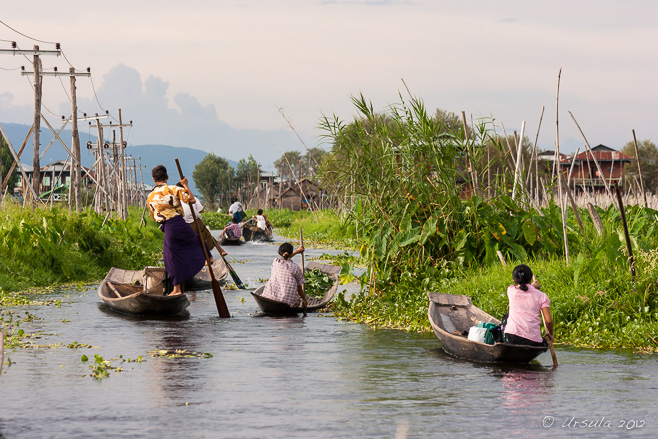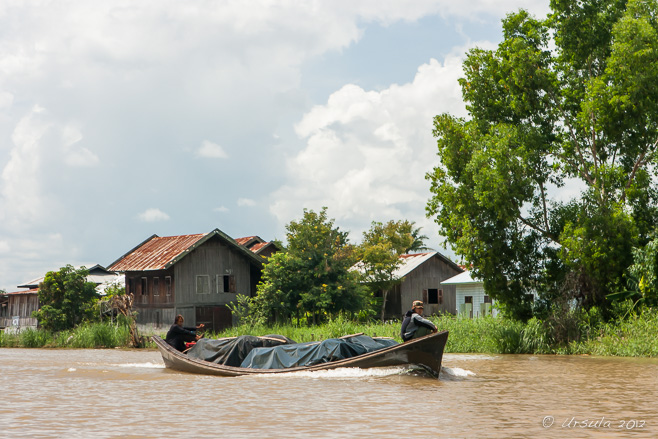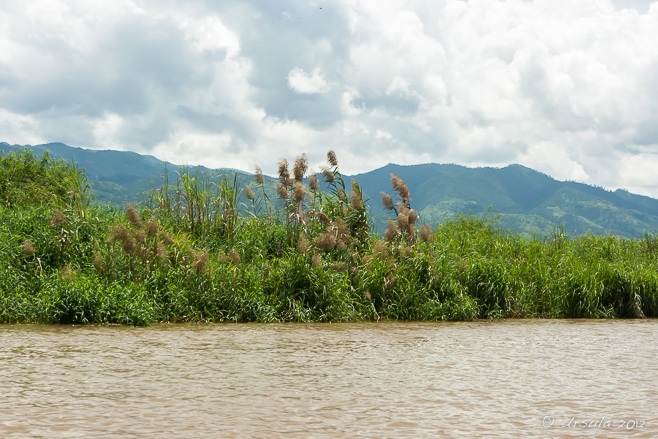
Leg Rowers and Paddlers
The water lanes through the floating fishermen’s village on Inlay Lake are busy with boat traffic.
It can be so easy – especially for people who have never travelled outside their own corner of the world – to take one’s way of life for granted: to feel entitled to a certain level of safety, opportunity and comfort.
But, imagine not being able to step outside your door because there is no solid ground beyond your simple wooden house. Imagine having to do everything – laundry, gardening, shopping, visiting, everything – from a boat. Imagine having to paddle or row everywhere. Imagine not being able to go for a walk or a run.
It is an eye-opener to see how some people live.
Inlay Lake, in the heart of Shan State, Myanmar, is home to about 70,000 Intha people. They are renowned for the unique leg-rowing style that the men use so that they can see over the floating plant life (see: Ursula’s Weekly Wanders: Iconic Images). Most Intha reside in villages and towns on the lake’s edge, but some live in simple houses made of wood and woven bamboo, raised up on stilts, over the lake itself. There they fish and tend their floating gardens.
One September afternoon I was privileged to tour one of these “floating” villages from the relative comfort of a wooden motorboat.

Boat on Inle Lake
Most of the transport on Inle Lake is via shallow wooden boats loaded to the gunwales. Many boats have simple unmuffled diesel motors: a troublesome source of water and noise pollution.

Grass and Mountains
The Shan Hills surround us. If it wasn’t for the unremitting noise of our motor, it would be beautifully peaceful on the lake.

Boat Operator
We race across the open waters…

Inle Lake Fisherman
… while a fisherman stands quietly on his anchored boat with his woven fish-basket behind him.

Spirit House
The Intha people are predominantly Buddhist, but some of the old Animist practices live on.

Giant Golden Chicken
Burmese barges often have giant golden chickens at the prow; I have no idea why.

House on Stilts
Raised up on poles, this house – unlike many others we saw – has a lovely large porch.

Jasmine Inle Retaurant
Our lunch stop is at a multi-story restaurant on the water…

View over the Lake
… where we had a wonderful meal in the airy rooms upstairs, …

Houses and Temple
… with views over the lake and the Shan Hills.

Restaurant Staff
Two women from the restaurant help push our boat back off after lunch.

Temple on Inle Lake

Boat on Inle Lake
The muddy waters are busy with heavily laden boats.

Farmer on the Lake
The poles allow the planted vegetables to climb – and also prevent the whole patch floating away.

Young Man on the Lake
Even the young take their turns checking the plants.

Women on the Lake
The water corridors extend through the vegetation.

Woman Paddling

Tending the Crops

Grocery Store
The stilted buildings crowd the narrow waterways …

Bringing Home the Groceries
… which are full of boats laden with people and baskets of goods.

Water Hyacinth ~ Eichhornia Crassipes
Although pretty, water hyacinth is a non-native pest which grows fast, clogging the smaller streams and depriving local plants and animals of light and food.

Little Girl at the Window
As our boats chug between the rows of houses, locals watch from the windows of their modest homes.

Woman at the Window

Old Woman at the Window

Man and Baby

Old Man
Some of the faces are as weathered as the wooden walls…

Fixing the Pole
What the neighbourhood lacks in amenities, it makes up for in community. A group of men works on getting new poles installed.

Afternoon Light
The afternoon light angles across the water, into our eyes, …

Old Man
… casting a warm glow on elderly faces.

Women on the Water
People call out to their neighbours as they row through the “streets”.

Young Rower
The lads start leg rowing at a young age – although I think this one is still having to concentrate.

On the Stoop
I can’t imagine how one safely contains active toddlers in houses that open directly onto the water!

Kite Flyer
Flying kites is one of the few activities available to kids without electronic gizmos – or local parks or playing fields.

A Last Look over the Water

Purple Evening
We head “home” when the light drops to the point where we can barely see… but the boats don’t stop.
One of my Facebook contacts is participating in a “30 days of gratitude” project, posting what she is grateful for daily. It has made my Newsfeed a much nicer place.
The world as a whole would be a nicer place if we all took notice of how lucky we are, instead of feeling entitled to all the “things” that we have – and more. After all, so many of the opportunities that come to us along the way are the byproduct of where and when we were born.
Every time I travel, I am grateful for the opportunity to visit new places. In many of these places, people have very few of the material advantages most of us take for granted. It reminds me just how different one’s day-to-day life can be, and I am always appreciative of the locals who are willing to share a little of their world with me.
 Until next time~
Until next time~
With thanks!
Pictures: 20September2012











































.png)


Ursula, I truly enjoyed this posting. Beyond the wonderful photography, you gave us a glimpse into these peoples lives and culture.
Thanks so much, Barry!
A bit different from your last lush Yellowstone NP set, isn’t it?
All the best, Ursula
[…] written before about it’s floating villages (Life on the Water) and about it’s distinctive leg-rowing fishermen (Iconic Images). Most of the […]
[…] square-mile (117 square-kilometer) lake is known for its leg-rowing Intha fishermen and its floating villages. Amongst the reeds and narrow waterways, the ethnic markets and buddhist pagodas are also worth a […]
[…] was in Nyaung Shwe on the north shore of Inle Lake in Myanmar, with photographer Karl Grobl, local guide Mr MM, and nine other photography […]